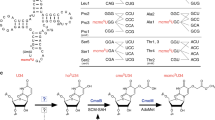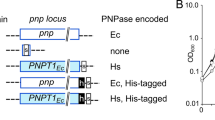Abstract
Organophosphate hydrolases (OPHs), involved in hydrolytic cleavage of structurally diverse organophosphates are coded by a plasmid borne, highly conserved organophosphate degrading (opd) gene. An inverted repeat sequence found in the signal coding region of the opd gene was found to be responsible for inducing a stable stem loop structure with a ΔG of −23.1 kcal/mol. This stem loop structure has shown significant influence on the expression levels of organophosphate hydrolase (OPH) in E. coli. When the signal coding region comprising the inverted repeat sequence was deleted a ∼3.28 fold increase in the expression levels of OPH was noticed in E. coli BL21 cells. Mutations in the inverted repeat region, especially at the third position of the codon, to a non-complementary base destabilized the secondary structure of opd mRNA. When such opd variant, opd′ was expressed, the expression levels were found to be similar to expression levels coded by the construct generated by deleting the signal peptide coding region. Deletion of signal peptide did not influence the folding and activity of OPH. Though high level induction has resulted in accumulation of OPH as inclusion bodies, modulation of expression levels by reducing the copy number of the expression plasmid, inducer concentration and growth temperature has produced majority of the protein in soluble and active form.



Similar content being viewed by others
References
Abd-Alla MH (1994) Phosphodiesterase and phosphotriesterase in Rhizobium and Bradyrhizobium strains and their roles in the degradation of organophosphorus pesticides. Lett Appl Microbiol 19:240–243
Benning MA, Kuo JM, Raushel FM, Holden HM (1994) The three-dimensional structure of phosphotriesterase: an enzyme capable of detoxifying organophosphorous nerve agents. Biochemistry 33:15001–15007
Brown KA (1980) Phosphotriesterase of Flavobacterium sp. Soil Biol Biochem 12:105–112
Chaudhry GR, Ali AN, Wheeler WB (1988) Isolation of a methyl parathion degrading Pseudomonas sp. that possesses DNA homologous to the opd gene from a Flavobacterium sp. Appl Environ Microbiol 54:288–293
Cheng TC, Harvey SP, Stroup AN (1993) Purification and properties of highly active organophosphorus acid anhydrase from Alteromonas undina. Appl Environ Microbiol 59:3138–3140
Cheng TC, Harvey SP, Chen GL (1996) Cloning and expression of a gene encoding a bacterial enzyme for decontamination of organophosphorus nerve agents and nucleotide sequence of the enzyme. Appl Environ Microbiol 62:1636–1641
Chu XY, Wu NF, Deng MJ, Tian J, Yao B, Fan YL (2006) Expression of organophosphorus hydrolase OPHC2 in Pichia pastoris: purification and characterization. Protein Expr Purif 49:9–14
DeFrank JJ, Cheng T (1991) Purification and properties of an organophosphorus acid anhydrate from a halophilic bacterial isolate. J Bacteriol 173:1939–1943
Horne I, Sutherland TD, Oakeshott JG, Russell RJ (2002) Cloning and expression of the phosphotriesterase gene hocA from Pseudomonas monteilii C11. Microbiology 148:2687–2695
Hoskin FCG, Roush AH (1982) Hydrolysis of nerve gas by squid type diisopropyl phosphorofluoridate hydrolysing enzyme on agarose resin. Science 215:1255–1257
Kozak M (2005) Regulation of translation via mRNA structure in prokaryotes and eukaryotes. Gene 361:13–37
Morales VM, Backman A, Bagdasarian M (1991) A series of wide-host-range low-copy-number vectors that allow direct screening for recombinants. Gene 97:39–47
Mulbry WW, Karns JS (1989) Parathion hydrolase specified by the Flavobacterium opd gene: relationship between the gene and protein. J Bacteriol 171:6740–6746
Mulbry WW, Karns JS (1989) Purification and characterization of three parathion hydrolases from gram-negative bacterial strains. Appl Environ Microbiol 55:289–293
Munneke DM, Hsieh DPH (1976) Pathways of microbial metabolism of parathion. Appl Environ Microbiol 31:63–69
Ohshiro K, Kakuta T, Nikaidou N, Watanabe T, Uchiyama T (1999) Molecular cloning and nucleotide sequencing of organophosphorus insecticide hydrolase gene from Arthrobacter sp. strain B-5. J Biosci Bioeng 87:531–534
Punginelli C, Ize B, Stanely NR, Stewart V, Sawers G, Berks BC, Palmer T (2004) mRNA secondary structure modulates translation of Tat-dependent formate dehyrogenase N. J Bacteriol 186:6311–6315
Rosenber AH, Lade BN, Chui DS, Lin SW, Dunn JJ, Studier FW (1987) Vectors for selective expression of cloned DNAs by T7 RNA polymerase. Gene 56:125–135
Rowland SS, Speedie MK, Pogell BM (1991) Purification and characterization of a secreted recombinant phosphotriesterase (parathion hydrolase) from Streptomyces lividans. Appl Environ Microbiol 57:440–444
Serdar GM, Gibson DT (1989) Enzymatic hydrolysis of organophosphates: cloning and expression of parathion hydrolase gene from Pseudomonas diminuta. Biotechnolgy 3:567–571
Serdar CM, Murdock DC, Rohde MF (1989) Parathion hydrolase gene from Pseudomonas diminuta MG: subcloning, complete nucleotide sequence, and expression of the mature portion of the enzyme in Escherichia coli. Bio/Technology 7:1151–1155
Siddavattam D, Khajamohiddin S, Manavathi B, Pakala SB, Merrick M (2003) Transposon-like organization of the plasmid-borne organophosphate degradation (opd) gene cluster found in Flavobacterium sp. Appl Environ Microbiol 69:2533–2539
Siddavattam D, Raju ER, Emmanuel Pual PV, Merrick M (2006) Overexpression of parathion hydrolase in Escherichia coli stimulates the synthesis of outer membrane porin OmpF. Pest Biochem Physiol 86:146–150
Steiert JG, Pogell BM, Speedie MK, Laredo J (1989) A gene coding for a membrane-bound hydrolase is expressed as a secreted soluble enzyme in Streptomyces lividans. Bio/Technology 7:65–68
Studier FW, Moffatt BA (1986) Use of bacteriophage T7 RNA polymerase to direct selective high-level expression cloned genes. J Mol Biol 189:113–130
Studier FW, Rosenberg AH, Dunn JJ, Dubendorff JW (1990) Use of T7 RNA polymerase to direct expression of cloned genes. Methods Enzymol 185:60–89
Tartof KD, Hobbs CA (1987) Improved media for growing plasmid and cosmid clones. Focus (Life Technologies) 9:12
Zhongli C, Shunpeng L, Guoping F (2001) Isolation of methyl parathion-degrading strain M6 and cloning of the methyl parathion hydrolase gene. Appl Environ Microbiol 67:4922–4925
Acknowledgements
We thank Dr. M. J. Merrick, John Innes Centre, Norwich, UK for useful suggestions and help while generating expression plasmids. The research work in the laboratory of DS is supported by Department of Science and Technology, New Delhi through grant-in-aid to a research project (SR/SO/BB-20/2004).
Author information
Authors and Affiliations
Corresponding author
Rights and permissions
About this article
Cite this article
Pandey, J.P., Gorla, P., Manavathi, B. et al. mRNA secondary structure modulates the translation of organophosphate hydrolase (OPH) in E. coli . Mol Biol Rep 36, 449–454 (2009). https://doi.org/10.1007/s11033-007-9200-5
Received:
Accepted:
Published:
Issue Date:
DOI: https://doi.org/10.1007/s11033-007-9200-5




